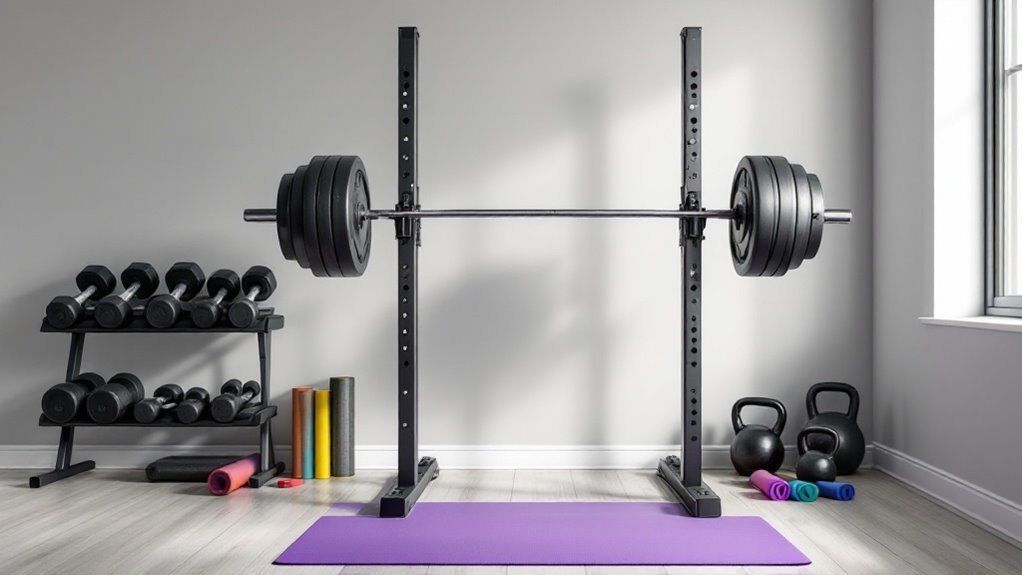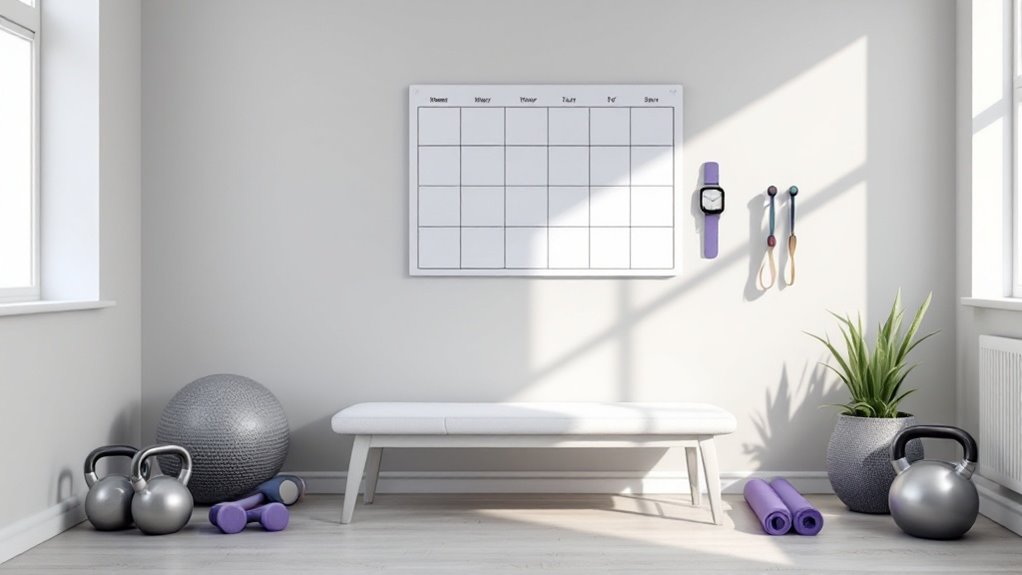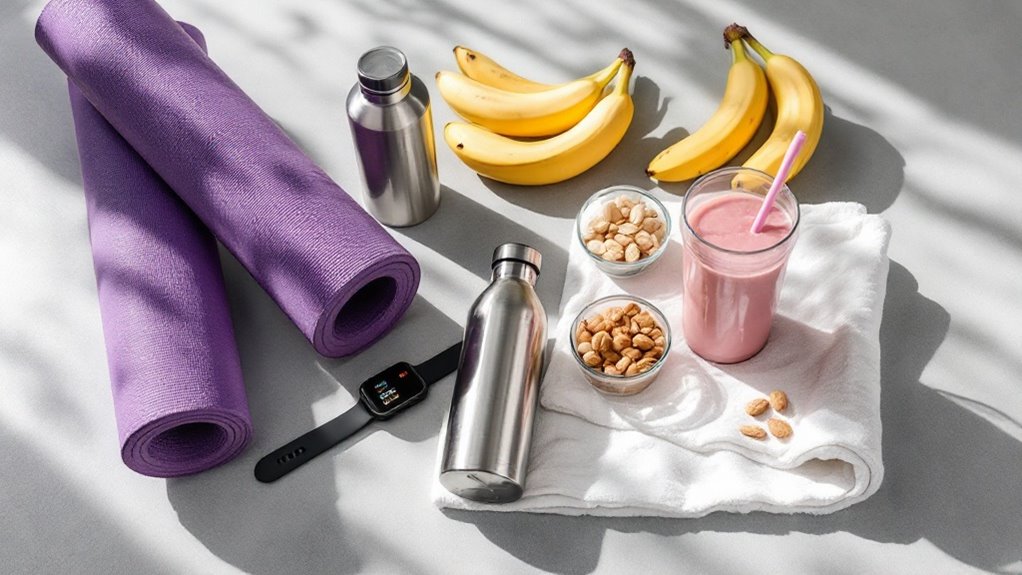Female Gym Workout Plan

A successful female gym workout plan combines three to four strength training sessions weekly, focusing on compound exercises like squats, deadlifts, and presses. The program alternates between upper and lower body days, incorporating moderate cardio and essential recovery time. Proper nutrition emphasizes lean proteins, complex carbs, and healthy fats, while adequate sleep and hydration support muscle development. This foundation sets the stage for understanding how women can optimize their unique physiological advantages.
Key Takeaways
- Train 3-4 days per week, alternating between upper and lower body workouts with dedicated rest days for recovery.
- Focus on compound exercises like squats, deadlifts, and bench presses to maximize muscle engagement and efficiency.
- Begin each workout with proper warm-up and maintain correct form to prevent injury and build strength effectively.
- Include both strength training and moderate cardio sessions throughout the week for balanced fitness development.
- Support workouts with adequate protein intake, hydration, and 7-9 hours of sleep for optimal results.
Understanding Female Fitness Fundamentals

Every woman's fitness journey begins with understanding the fundamental principles that make female physiology unique.
Women generally have higher body fat percentages, different hormonal profiles, and distinct muscle development patterns compared to men.
Female bodies carry unique biological traits – from higher essential fat and complex hormones to distinctive ways of building strength.
Key fundamentals include understanding that women tend to build lean muscle more gradually, have different nutritional needs based on menstrual cycles, and may require modified training approaches during pregnancy or postpartum periods.
Effective female fitness focuses on compound movements, progressive overload, and balanced nutrition while considering hormonal fluctuations throughout the month.
Success comes from recognizing these biological differences and tailoring workout programs accordingly, rather than following generic training plans.
Regular strength training routines can significantly boost metabolism and improve bone density while maintaining a lean physique.
Essential Strength Training Exercises for Women

While many women initially hesitate to incorporate strength training into their routines, compound exercises form the foundation of an effective female fitness program. Core movements like squats, deadlifts, bench presses, and overhead presses build functional strength and boost metabolism.
These fundamental exercises involve multiple muscle groups simultaneously, maximizing workout efficiency and promoting lean muscle development. When performed with proper form, they improve posture, increase bone density, and create a stronger physique.
Starting with bodyweight variations allows beginners to master technique before progressing to weighted movements.
Following a structured progressive overload approach helps ensure consistent strength gains while maintaining proper form and preventing injury.
Regular strength training empowers women to achieve their fitness goals while developing physical and mental resilience.
Creating a Balanced Weekly Workout Schedule

Structuring an effective weekly workout schedule requires careful planning and strategic arrangement of training sessions to optimize results. A balanced plan typically includes three to four strength training days alternating with cardio sessions, allowing proper recovery between muscle groups.
Monday and Thursday can focus on upper body exercises, while Tuesday and Friday target lower body movements.
Wednesday and Saturday are ideal for moderate-intensity cardio and core work. Sunday serves as a complete rest day or active recovery through light activities like walking or yoga.
This structured approach prevents overtraining while maintaining consistent progression toward fitness goals. Following this schedule helps women build lean muscle mass without developing the bulky appearance many incorrectly associate with weightlifting.
Nutrition and Recovery Tips for Optimal Results

Proper nutrition and strategic recovery form the foundation of any successful fitness journey, working collaboratively with exercise to improve results. A balanced diet rich in lean proteins, complex carbohydrates, and healthy fats fuels muscle recovery and growth.
Post-workout nutrition timing is essential, with protein intake within 30 minutes after exercise.
Maximize your workout results by consuming quality protein within the critical 30-minute window following intense exercise.
Quality sleep, averaging 7-9 hours nightly, allows the body to repair and adapt. Active recovery days should include light movement, stretching, or yoga.
Proper hydration, aiming for half your body weight in ounces of water daily, supports muscle function and reduces fatigue. Strategic rest between workouts prevents overtraining and optimizes progress.
Developing sustainable eating patterns through gradual dietary changes helps maintain long-term fitness success without feeling deprived.
Frequently Asked Questions
How Long Should I Wait After Giving Birth Before Starting Gym Workouts?
Medical professionals recommend waiting 6-8 weeks after giving birth before resuming exercise, pending doctor clearance.
Recovery timelines vary based on delivery type – vaginal births typically allow earlier returns than C-sections.
Starting with gentle postpartum exercises like walking and pelvic floor work is advised before progressing to more intense workouts.
Each person's recovery journey differs, making medical guidance essential.
Can Certain Exercises Help Reduce Menstrual Pain and Discomfort?
While some might curl up in despair during that time of the month, science has a better battle plan.
Regular exercise, particularly yoga poses like child's pose and cat-cow stretches, can greatly reduce menstrual discomfort. Low-impact cardio, gentle core work, and pelvic exercises increase blood flow and release endorphins – nature's painkillers.
Swimming and walking also help ease cramps and boost mood through natural movement therapy.
Should I Adjust My Workout Routine During Different Phases of Menstruation?
Adjusting workout routines during menstrual phases helps optimize performance and recovery.
During menstruation, focus on light cardio and moderate strength training.
The follicular phase supports high-intensity workouts and strength gains.
The ovulatory phase is ideal for challenging exercises, while the luteal phase calls for reduced intensity.
Listen to the body's signals and modify exercise intensity, volume, and type as needed.
Will Lifting Weights Affect My Breast Size or Shape?
Powerfully pushing and pulling weights won't purposely diminish breast tissue.
Weight training primarily affects muscle tissue beneath the breasts, not the fatty tissue that determines breast size.
The chest muscles (pectorals) can become more toned, potentially creating a lifted appearance.
Some women report improved posture from strength training, which can elevate overall chest aesthetics.
Genetics and body fat percentage remain the key determinants of breast size.
How Can I Prevent Exercise-Related Hair Damage and Maintain Healthy Skin?
To protect hair during exercise, wear loose hairstyles, use silk/satin hair ties, and avoid tight ponytails that cause breakage.
Post-workout, wash with sulfate-free shampoo and deep condition regularly.
For skin health, cleanse immediately after exercise, use non-comedogenic sunscreen, stay hydrated, and wear moisture-wicking fabrics.
A balanced diet rich in vitamins A, C, and E supports both hair and skin health.
Final Thoughts
While some may hesitate to start a gym routine due to intimidation or fear of "bulking up," women who follow a structured fitness plan discover remarkable transformations in strength, confidence, and overall wellness. By combining targeted strength training, balanced workouts, and proper nutrition, females can achieve their fitness goals efficiently and sustainably. The journey to a stronger, healthier self begins with taking that first step into the weight room.


